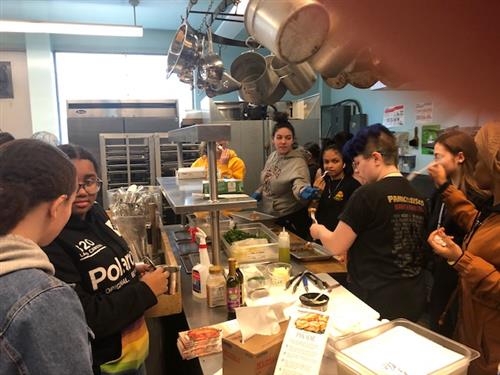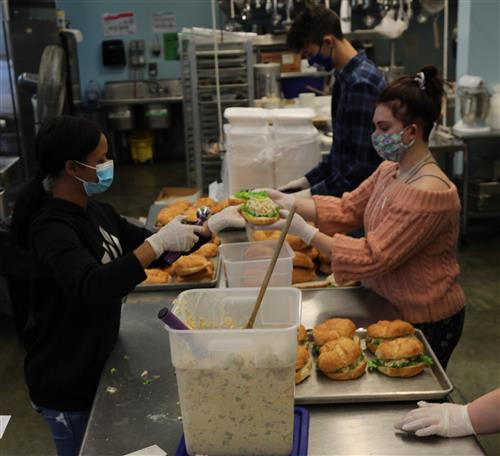Culinary Arts
Page Navigation
- Erie High School
- Overview
-
Culinary Arts (Institutional Food Worker)


Culinary Arts Video
CIP: 12.0508
Pathway: HUMAN SERVICES
Instructors: Jillian Zelina-Anderson and Paul Blackmer
Certifications: OSHA 10, S/P2, ServeSafe, ProStartIntroduction - Program of Study
Cooks and food preparation workers prepare a wide range of foods, from soups, snacks, and salads to entrees, side dishes, and desserts. They work in a variety of restaurants, as well as other places where food is served, such as grocery stores, schools and hospitals. Cooks prepare and cook meals while food preparation workers assist cooks by performing tasks, such as peeling and cutting vegetables, trimming meat, preparing poultry, and keeping work areas clean and monitoring temperatures of ovens and stovetops.
Food preparation workers perform routine, repetitive tasks under the direction of chefs, head cooks, or supervisors. These workers prepare the ingredients for complex dishes by slicing and dicing vegetables, and making salads and cold items. They weigh and measure ingredients, retrieve pots and pans, and stir and strain soups and sauces. Food preparation workers may also cut and grind meats, poultry, and seafood in preparation for cooking.
Larger restaurants and food service establishments tend to have varied menus and larger kitchen staffs. Teams of restaurant cooks called assistant or linecooks, may be called to function in these large establishments. Each team has an assigned station that is equipped with the types of stoves, grills, pans, and ingredients needed for the foods prepared at that station. Job titles often reflect the principal ingredient prepared or the type of cooking performed, such as vegetable cook, fry cook, or grill cook.
Specifically, cooks measure, mix, and cook food according to recipes. The number, type and responsibilities of cooks vary depending on where they work, the size of the facility, and the complexity and level of service offered. Institution and cafeteria cooks, for example, work in the kitchens of schools, cafeterias, businesses, hospitals, and other institutions. For each meal, they prepare a large quantity of a limited number of entrees, vegetables, and desserts according to preset menus. Meals are generally prepared in advance so diners seldom get the opportunity to special order a meal.
Restaurant cooks usually prepare a wider selection of dishes, cooking most orders individually. Shortorder cooks prepare foods in restaurants and coffee shops that emphasize fast service and quick food preparation. They grill and garnish hamburgers, prepare sandwiches, fry eggs, and cook french fries, often working on several orders at the same time. Fast food cooks prepare a limited selection of menu items in fastfood restaurants. They cook and package food, such as hamburgers and fried chicken, to be kept warm until served.
After gaining valuable experience on the job, cooks and food preparation workers may be promoted to kitchen managers or food service supervisors. These individuals purchase supplies, train workers, compile and balance cash receipts, and observe and evaluate work procedures to ensure quality standards and services are met.
Assumptions of this Program of Study
High quality programs should meet the following standards:
- Promote positive working relationships.
- Implement a curriculum that fosters all areas of skill development
- Use appropriate and effective teaching approaches.
- Provide ongoing assessments of student progress.
- Employ and support qualified teaching staff.
- Establish and maintain relationships and use resources of the community.
- Provide a safe and healthy learning environment.
- Implement strong program organization and supervision policies that result in high quality teaching and learning.
- Integrate academic skills and aptitudes necessary for postsecondary education, gainful employment and a foundation of lifelong learning.
CIP code: 12.0508
Culinary Arts is an instructional program that prepares students for employment related to institutional, commercial or self-owned food establishments or other food industry occupations. Instruction and specialized learning experiences include theory, laboratory and work experience related to planning, selecting, preparing and serving of quantity food and food products; nutritive values; use and care of commercial equipment; safety; and sanitation precautions. Instruction skills are provided to individuals desiring to become employed in all areas of the food service industry at entry level.
More Information
The courses in our Culinary Arts program will let you explore the many aspects of one of the world's fastest growing professions. During your four-years of training, you will learn the art of menu planning and basic food preparation. You will get training in management and service skills. Plus you'll learn about nutrition, proper food handling, use and care of commercial equipment, plus safety sanitation.

